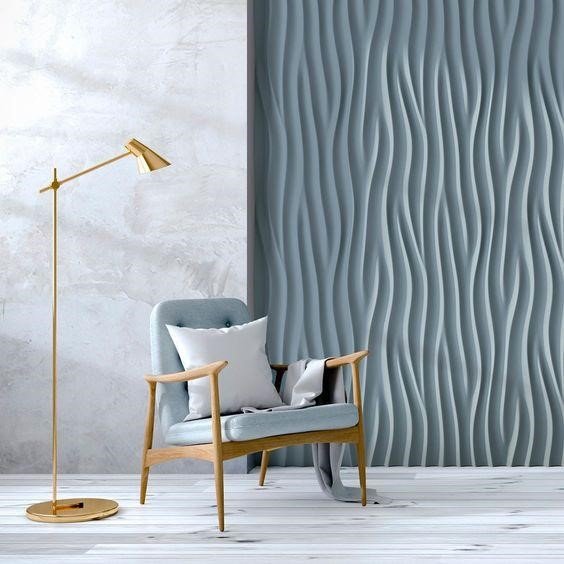Wall Paneling in the Living Room: Importance of Wall Paneling

Introduction:
Wall
paneling has emerged as a versatile and stylish design element that plays a
pivotal ole in transforming the aesthetics and functionality of the living
room. It involves the application of panels or boards onto walls, offering a
wide array of textures, colors, and finishes to suit various decor styles.
Beyond its decorative appeal, wall paneling also serves practical purposes such
as providing insulation, soundproofing, and protection for the underlying wall
surfaces.
Understanding Wall Paneling:
Wall
paneling encompasses a diverse range of materials and techniques, each
contributing unique visual and tactile qualities to the living room. This can
include classic wood paneling characterized by beadboard or shiplap designs,
which bring warmth and character to traditional and rustic interiors. On the
other hand, modern options like MDF or HDF panels offer sleek and minimalist
profiles, ideal for contemporary living spaces seeking a clean aesthetic.
Decorative wall tiles, such as ceramic or 3D tiles, introduce texture and
depth, making a striking statement in the living room.

Types of Wall Paneling Designs
Wood Paneling:
- Traditional Wood Paneling: This category includes classic designs such as beadboard, wainscoting, or tongue-and-groove panels. These styles evoke a sense of timeless elegance and craftsmanship, often seen in traditional or rustic interiors. Beadboard features narrow vertical planks with distinctive grooves, adding texture and character to walls. Wainscoting typically consists of wooden panels installed on the lower half of walls, providing a decorative and protective element. Tongue-and-groove panels interlock seamlessly, creating a cohesive and visually pleasing surface.
- Modern
Wood Paneling: Embracing contemporary aesthetics, modern wood panels feature
clean lines, natural finishes, and minimalist profiles. These panels cater to
Scandinavian-inspired interiors and modern design themes. With sleek surfaces
and subtle detailing, modern wood paneling offers warmth and sophistication
without overwhelming the space, making it ideal for urban dwellings seeking a
refined yet inviting ambiance.
MDF or HDF Panels:
- Flat Paneling: Flat panels are characterized by smooth surfaces without visible joints or detailing, creating a seamless and contemporary look. This style is popular in urban and minimalist interiors, where simplicity and clean aesthetics are key. Flat paneling complements modern furniture and decor, providing a versatile backdrop that highlights other design elements within the living room.
- Textured
Panels: Embossed or textured panels add visual interest and depth to walls, enriching
the overall decor of the living room. Textured panels come in a variety of
patterns, from subtle geometric motifs to organic textures resembling natural
materials like stone or wood grain. These panels create a tactile experience,
inviting touch and enhancing the sensory appeal of the living space.
Decorative Wall Tiles:
- Ceramic or Porcelain Tiles: Ceramic and porcelain tiles offer durability, moisture resistance, and a vast range of design options. These tiles come in various colors, patterns, and sizes, allowing for creative customization in the living room. Ceramic tiles can mimic the look of natural materials like marble or wood, providing a cost-effective and low-maintenance alternative.
- 3D
Wall Tiles: Transform plain walls into dynamic focal points with 3D wall tiles
that introuce an element of dimensionality. Sculptural tiles play with light
and shadow, creating captivating visual effects. Whether used as an accent wall
or to cover entire surfaces, 3D tiles add texture and artistic flair to the
living room, enhancing its aesthetic appeal.
Benefits of Wall Paneling Designs
Enhanced Aesthetics:
Wall paneling brings texture, depth, and architectural interest to
the living room, allowing for creative expression and customization. Whether
using traditional wood paneling or modern MDF panels, wall treatments elevate
the overall decor and contribute to a cohesive design scheme.
Surface Protection:
Panels provide a durable and protective surface that shields walls
from wear and tear, enhancing longevity and minimizing maintenance
requirements. This benefit is especially valuable in high-traffic areas of the
living room prone to scuffs, scratches, or moisture exposure.
Insulation and Soundproofing:
Certain paneling materials contribute to thermal insulation
and sound absorption, creating a more comfortable and acoustically pleasant
living environment. This is particularly advantageous in open-concept living
spaces where noise control and temperature regulation are important
considerations.
Disadvantages of Wall Paneling
Cost Considerations:
High-quality wall paneling materials and installation can be
costly, especially for larger living rooms or intricate designs. Budget
constraints may limit the selection of premium paneling options, necessitating
careful planning and prioritization.
Maintenance Needs:
Some paneling materials require periodic maintenance or refinishing to
preserve their appearance and structural integrity over time. Wood panels may need
to be treated with protective coatings to prevent warping or discoloration,
adding to maintenance efforts and costs.
Considerations When Choosing Wall Paneling Designs
Design Compatibility:
Select wall paneling designs that harmonize with the existing decor
style, architectural features, and color palette of the living room. Consider
the overall theme and ambiance you wish to achieve, ensuring that paneling
choices complement other design elements seamlessly.
Material Durability:
Prioritize durable and low-maintenance paneling materials that can
withstand daily use and envronmental factors. Evaluate the durability,
resistance to moisture, and longevity of different paneling options to make
informed decisions based on lifestyle and maintenance preferences.
Installation Complexity:
Evaluate the complexity of installation and associated costs to
ensure that the chosen wall paneling design aligns with budgetary and timeline
constraints. Consider hiring professional installers for intricate designs or
specialized materials to achieve optimal results and minimize installation
challenges.
Factors Influencing Wall Paneling Choices
Budget Allocation:
Define a clear budget for wall paneling projects, encompassing
material costs, labor fees, and any customization or finishing details. Explore
cost-effective alternatives and prioritize investments based on long-term value
and impact on the living room's aesthetics.
Personal Style and Preferences:
Consider individual design preferences, lifestyle needs,
and aesthetic goals to select wall paneling designs that reflect personal taste
and enhance the living room ambiance. Incorporate elements that resonate with
your unique style and contribute to a cohesive and inviting livingspace.
Room Characteristics:
Evaluate the size, layout, and architectural elements of the
living room to determine the most suitable wall paneling options that optimize
space and visual impact. Adapt paneling choices to accommodate room
proportions, lighting conditions, and functional requirements for a harmonious
and well-balanced design.
Conclusion:
Wall paneling designs represent a dynamic and versatile approach to enhancing the aesthetics and functionality of the living room. By exploring the diverse types, benefits, considerations, and factors associated with wall paneling choices, homeowners can make informed decisions to create a captivating and personalized living space that embodies their unique style and vision









